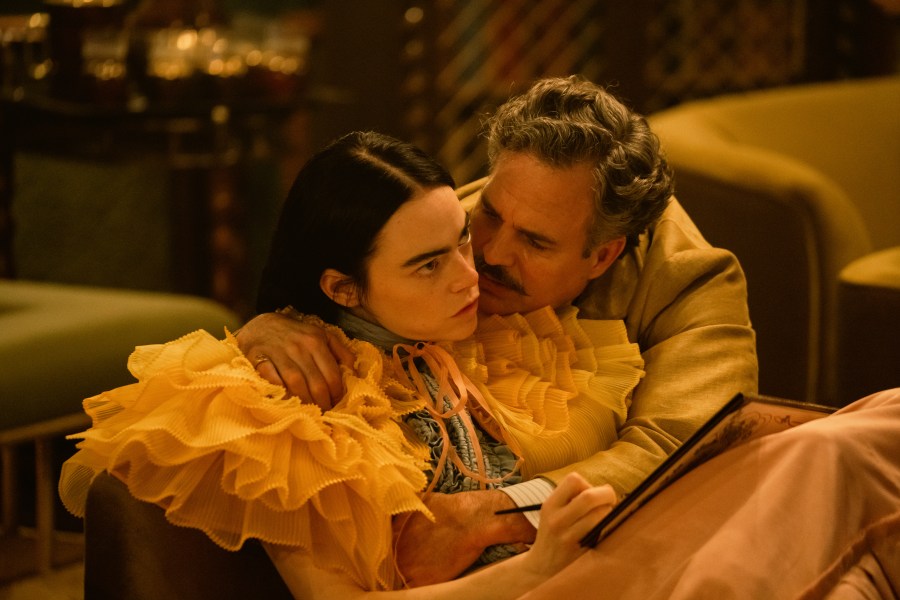By John Corrado
★★★★ (out of 4)
 Poor Things is the latest from Greek director Yorgos Lanthimos following his break into more “mainstream” filmmaking with his Oscar-winning The Favourite, and it’s a weird and wonderful take on the Frankenstein story.
Poor Things is the latest from Greek director Yorgos Lanthimos following his break into more “mainstream” filmmaking with his Oscar-winning The Favourite, and it’s a weird and wonderful take on the Frankenstein story.
Adapting Scottish writer Alasdair Gray’s 1992 novel of the same name for the screen, Lanthimos delivers a wildly entertaining, at times surrealist work. The film gives us a lot to take in, from lavish production design and costumes to absurdist humour, with some philosophical ideas underneath it all.
The story centres around the awakening of Bella (Emma Stone), who is the result of an adult woman’s dead body being reanimated by having a baby brain put in her head. Bella’s “creator” is a man named Dr. Godwin Baxter (Willem Dafoe), a mad scientist who lives with various chimeras (like a French bullduck and a chicken-dog), and likes to experiment on the dead.
At the start of the film, Bella is seen banging madly on the piano, essentially a toddler stuck in a grown up body. The job of studying Bella falls upon Max McCandless (Ramy Youssef), a young medical student that Dr. Godwin (whom Bella refers to as “God”) hires as his assistant. But Bella quickly starts to mature as she goes through “puberty.” Her world begins to open up when she meets Duncan Wedderburn (Mark Ruffalo), a lawyer and suitor who helps her discover more carnal pleasures (I’m surprised the film isn’t rated NC-17 with the amount of freewheeling sex and nudity).
As she starts to venture out of the lab and into the real world, the once puerile Bella begins to seek various forms of liberation and her own agency (her “feminist” awakening weirdly makes this feel like a bizarro, R-rated companion piece to Greta Gerwig’s Barbie). Despite the larger, more fantastical canvas that he is working on, Poor Things still bears the hallmarks of a Lanthimos film. There are shades of his breakout movie Dogtooth in the way the characters talk and the recurrent themes of repression and emergent sexual exploration, but by way of Terry Gilliam.
Shot mainly on soundstages in Budapest, the steampunk-inspired, pastel-coloured, not-quite-real look of this world adds to the experience. The cinematography by Robbie Ryan, who previously worked with Lanthimos on The Favourite, uses the same fish-eye lenses that present things at eccentric angles. This accentuates the way that Victorian England is rendered onscreen, with Poor Things having a unique visual style that is often wondrous to behold (the film begins in black-and-white, before moving into colour).
The film is carried by a sublime tragicomic turn from Stone, who brilliantly portrays Bella’s growing process. Her work is at once hilarious, commanding, and sympathetic. She is essentially tasked with playing a character from infancy to early adulthood, and it’s a fascinating gambit that the actress pulls off exceptionally well. Stone not only portrays the character’s emotional arc as she discovers more about her origins, but it’s an incredible physical performance as well; from the way her movements become more natural as she “grows up,” to the evolution of her speech. Ruffalo, meanwhile, gets major laughs by chewing up the screen playing a slimy cad.
The magic of Poor Things lies in watching Stone’s Bella come into her own. She discovers the joys of being alive, but also the cruelty of the world, especially the men who seek to control or take advantage of her. It’s the whole spectrum of the human experience that she encounters. And what a weird, wonderful, bizarrely funny, visually splendorous odyssey we are taken on alongside her.

Poor Things opens exclusively in theatres in limited release on December 15th.